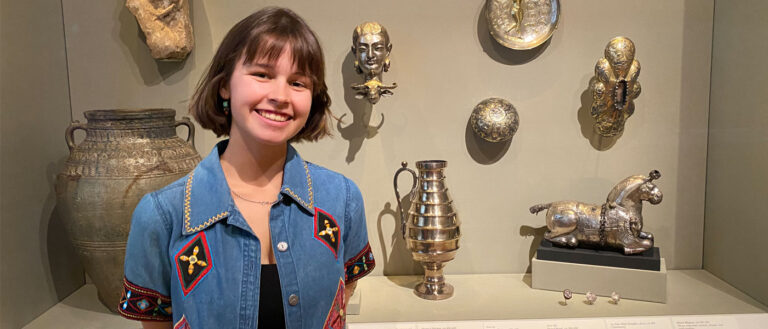Like many incoming students at Case Western Reserve, Elie Stenson thought she knew for certain what field she would pursue. With her focus on STEM, she enrolled in other courses “on a whim,” including the course “Introduction to Social and Cultural Anthropology and Art and Culture in Cleveland.”
The decision was life changing. Stenson—now a rising fourth-year student—went on to major in art history and anthropology with a concentration in archaeology.
Originally from Pittsburgh, Stenson’s studies took her to the Gila National Forest in New Mexico for an archaeological field school the summer following her first year. Hosted by the University of Arizona and Archaeology Southwest, the opportunity allowed her to participate in the excavation of a 13th-14th century settlement built by the indigenous Kayenta peoples after they experienced a period of drought.
“This opportunity sparked my interest in how communities encode their experiences facing major events such as climate change, colonization, and acculturation into their material cultures,” Stenson said. “It also helped me discover my love for field work and classic country music!”
Learn more about Stenson’s work in art history and anthropology.
Answers have been lightly edited for clarity and length.
1. What drew you to Case Western Reserve University?
I appreciate the flexibility of the CWRU curriculum and how it encourages students to fully pursue their various interests both in and outside of the classroom. I also like how CWRU’s location opens up lots of opportunities to explore Cleveland. This city is full of unique cultural traditions, welcoming neighborhoods and entertainment—and CWRU is right in the middle of all of it.
2. What do you enjoy most about your area of study?
Countless people have walked the planet before us, and every single one of them has a story to tell. It’s exciting to be able to stand in their footsteps and unearth the artifacts of their lives; in a way it’s like going back in time and having a conversation with them. There is so much value in all of our lives, and it’s a privilege to be able to amplify some of the diverse perspectives that have defined this country’s history through my work.
3. Can you briefly describe your research topic?
I’m fascinated by all aspects of North American archaeology, but I’m particularly interested in the early Contact period and how indigenous communities recorded their responses to European colonization through their artistic production.
4. What do you hope will come from your research?
It’s important that we consider U.S. history from the perspective of indigenous communities, both present-day and prehistoric. Unfortunately, a lot of our understanding of this nation’s past is eclipsed by deeply rooted colonial narratives, but this makes it all the more essential for us to excavate and curate the North American archaeological record in an ethical, inclusive manner that uplifts indigenous voices.
5. Are you involved on campus in any other ways?
I’m the co-president of the undergraduate Art History Club and a member of the campus tour guide leadership team in the Office of Undergraduate Admissions. I’ve also volunteered for the Cleveland Museum of Natural History’s Archaeology Lab.
6. Have you had any internships, volunteer positions or other experiential experiences?
This is my second summer interning for Christine Davis Consultants, a cultural resource management firm in Pittsburgh. We conduct surveys and excavations of both prehistoric and historic sites in order to record their archaeological context ahead of development projects. This means we preserve, document, and curate materials attributed to many different peoples and periods of occupation. I am learning so much from the amazing crew and am grateful for the chance to spend lots of time in the field!


